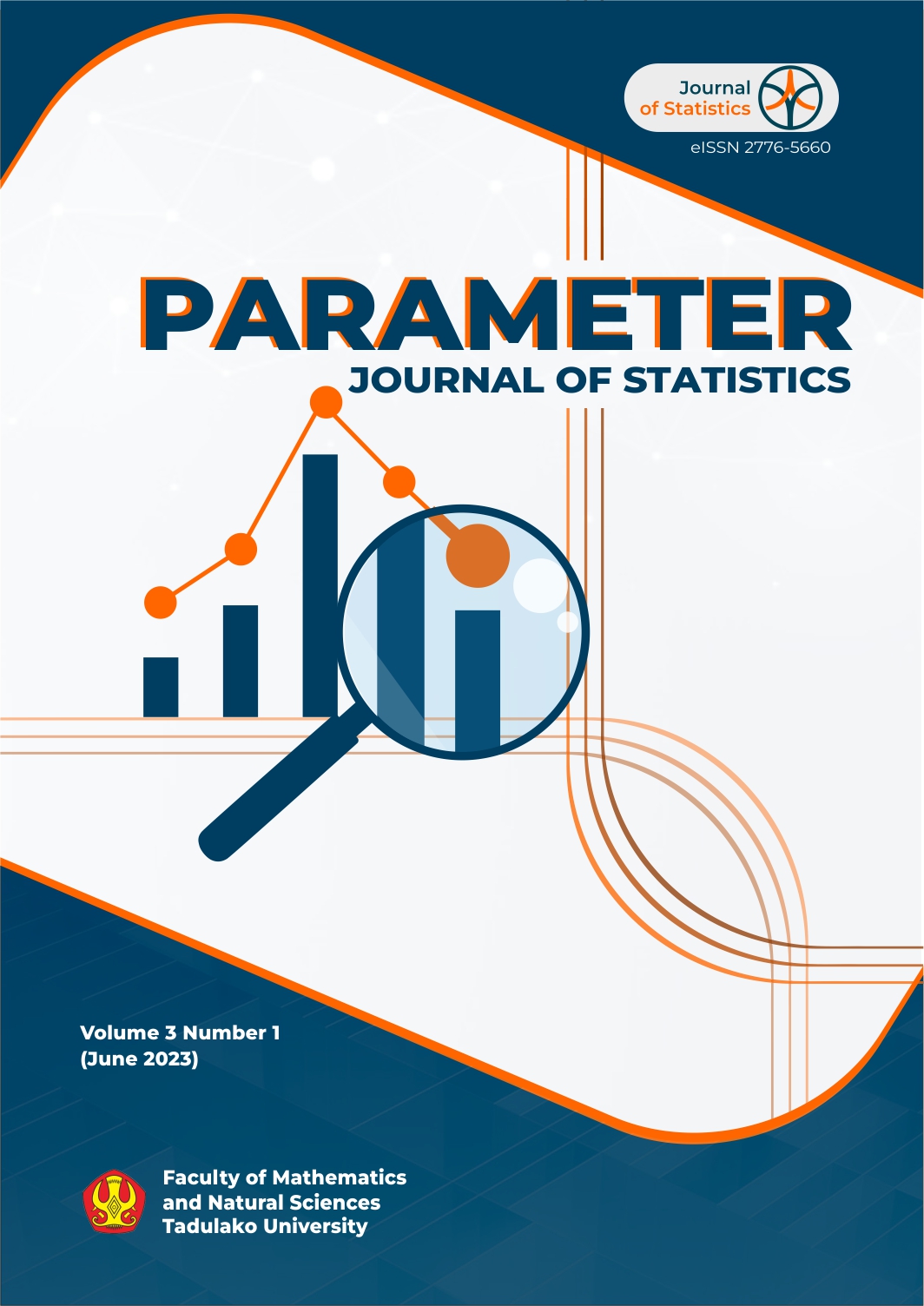Main Article Content
Abstract
Poverty is a problem that continues to be faced, especially in developing countries such as Indonesia. Poverty is included in one of the Sustainable Development Goals (SDGs) programs, which is related to hunger and health. The time series data can be clustered based on the characteristics of the time series data and adjusted to the time series pattern. The choice of distance and method used must be adjusted to the dynamic structure of time series data. The purpose of this research is to cluster districts/cities in Central Java Province based on the poverty depth index value from 2017 to 2022. The variable that used in this research is the Poverty Depth Index of 35 districts in Central Java Province from 2017 to 2022. This research used cluster time series with DTW similarity measurment. Based on theDTW and cophenetic coefficient correlation value using three linkage methods, the average linkage method has the highest cophenetic coefficient correlation value of 0.8017988. Testing the quality of clusters using the silhouette coefficient using DTW distance and average linkage method and 2 clusters are included in the good cluster category with a silhouette coefficient value of 0.60. The resulting clusters using the DTW distance and average linkage method are cluster 1 consisting of 25 districts / cities and cluster 2 consisting of 10 districts.
Keywords
Article Details

This work is licensed under a Creative Commons Attribution-ShareAlike 4.0 International License.
References
- Badan Perencanaan Pembangunan Nasional. (2023). No Title. https://simreg.bappenas.go.id/home/pemantauan/tk
- Buaton, R., Zarlis, M., Mawengkang, H., & Effendi, S. (2019). Clustering Time Series Data Mining dengan Jarak Kedekatan Manhattan City. Prosiding Seminar Nasional Riset Information Science (SENARIS), 1(September), 1155. https://doi.org/10.30645/senaris.v1i0.129
- Dani, A. T. R., Wahyuningsih, S., & Rizki, N. A. (2020). Pengelompokkan Data Runtun Waktu menggunakan Analisis Cluster (Studi Kasus: Nilai Ekspor Komoditi Migas dan Nonmigas Provinsi Kalimantan Timur Periode Januari 2000-Desember 2016). Jurnal EKSPONENSIAL, 11(1), 29–38.
- Kaufman, Leonard; Rousseeuw, P. J. (1990). Finding Groups In Data An Introduction to Cluster Analysis. A John Wiley & Sons.
- Lestari, W. I. (2022). Faktor-Faktor Yang Mempengaruhi Kemiskinan Per Provinsi Di Indonesia Dalam Perspektif Islam. Jurnal Ilmiah Ekonomi Islam, 8(03), 3136–3144. https://jurnal.stie-aas.ac.id/index.php/jei/article/view/6208%0Ahttps://jurnal.stie-aas.ac.id/index.php/jei/article/download/6208/2820
- Lisa Anggraini, Prizka Rismawati Arum, M. S. (2021). Analisis Cluster Menggunakan Algoritma K-Means Pada Provinsi Sumatera Barat Berdasarkan Indeks Pembangunan Manusia Tahun 2021. 11. https://prosiding.unimus.ac.id/index.php/semnas/article/viewFile/1214/1211
- Munthe, A. D. (2019). Penerapan Clustering Time Series Untuk Menggerombolkan Provinsi Di Indonesia Berdasarkan Nilai Produksi Padi. Jurnal Litbang Sukowati : Media Penelitian Dan Pengembangan, 2(2), 11. https://doi.org/10.32630/sukowati.v2i2.61
- Nafi’ah, B. (2021). Analisis Faktor-Faktor Yang Dapat Mempengaruhi Pengentasan Kemiskinan Di Indonesia (2016- 2019). Jurnal Ilmiah Ekonomi Islam, 7(2), 953–960. https://doi.org/10.29040/jiei.v7i2.2206
- Pusat Statistik, B. (2022). No Title. https://www.bps.go.id/indicator/23/503/1/indeks-kedalaman-kemiskinan-p1-menurut-provinsi-dan-daerah.html
- Pusat Statistik, B. (2023). Berita Resmi Statistik. https://www.bps.go.id/website/images/Kemiskinan-Sep-2022-ind.jpeg
- Soleha, H. A., Nurmayanti, W. P., Hidayaturrohman, U., Haiban, R., Tgkh, J., Abdul, M. Z., & No, M. (2022). Penerapan Clustering Time Series pada Pengelompokan Provinsi di Indonesia ( Studi Kasus : Nilai Ekspor Non Migas di Indonesia Tahun 2016-2020 ) Program Studi Statistika , Universitas Hamzanwadi. 15(2), 286–291.
- Suhaeni, C., Kurnia, A., & Ristiyanti, R. (2018). Perbandingan Hasil Pengelompokan menggunakan Analisis Cluster Berhirarki, K-Means Cluster, dan Cluster Ensemble (Studi Kasus Data Indikator Pelayanan Kesehatan Ibu Hamil). Jurnal Media Infotama, 14(1). https://doi.org/10.37676/jmi.v14i1.469
- Yanti, Y., & Rahardiantoro, S. (2018). ( Studi Kasus Penggerombolan Provinsi di Indonesia Berdasarkan. 13–22.
- Yusfar, A. A., Tiro, M. A., & Sudarmin, S. (2020). Analisis Cluster Ensemble dalam Pengelompokan Kabupaten/Kota di Provinsi Sulawesi Selatan Berdasarkan Indikator Kinerja Pembangunan Ekonomi Daerah. VARIANSI: Journal of Statistics and Its Application on Teaching and Research, 3(1), 31. https://doi.org/10.35580/variansiunm14626
